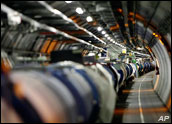
IBM researchers unveiled a new generation of experimental computer chips Thursday. The chips are designed to mimic the brain’s abilities of perception, action and cognition. The development could lead to advances in computers that require much less power and space than current technology.
IBM’s first neurosynaptic computing chips recreate the spiking neurons and synapses of biological systems such as the brain by using advanced algorithms and silicon circuitry. The first two prototype chips have been fabricated and are undergoing testing.
Systems built with these chips will be called “cognitive computers” and won’t be programmed the same way as traditional computers. Cognitive computers are expected to learn through experiences, find correlations, create hypotheses and remember, mimicking the brain’s structural and synaptic plasticity. IBM is combining principles from nanoscience, neuroscience and supercomputing to kick off a multi-year cognitive computing initiative.
IBM and its university collaborators have been awarded approximately US$21 million in new funding from the Defense Advanced Research Projects Agency (DARPA) for phase two of the Systems of Neuromorphic Adaptive Plastic Scalable Electronics (SyNAPSE) project. SyNAPSE’s goal is to create a system to analyze complex information from multiple sensory modalities at once and to dramatically rewire itself to adapt to the environment.
Computerized Learning, My Dear Watson
Giving a computer the ability to learn changes the way it works. Today’s computers react to human input and programming, while a learning computer would process information differently. The new chip is a step closer to actual learning than even the Watson computer used on “Jeopardy” to respond to questions.
“You can think of this like Watson, since both systems have the ability to learn,” Kelly Sims, communications manger at IBM Research, told TechNewsWorld. “It has to be a learning system because you can’t program a computer for every possible question. The computer has to be able to guess what the different data mean. Typical computer calculations are limited by programming. You can’t program a computer to know everything.”
IBM is implementing its hardware knowledge to fabricate a new type of computer. IBM dreams of a computer that is more aware of its surroundings and is ready to learn from them.
“What we’re trying to do is create something that can take in different information from senses and come up with an understanding of what is going on,” said Sims. “Watson was designed to answer deep questions and answers, to understand and find answers in natural language. The underlying hardware involved is the same hardware we’ve been using for 50 years.”
Computers today are reaching the walls of physics, which could stymie the uninterrupted progress of faster and deeper computations.
“Computers today face a number of problems. One is Moore’s Law. We’re coming to physical limitations. You have to make the computer go faster to get more out of them. We could build a computer that could know almost everything, but it would be the size of Manhattan and it would take just as much energy.”
Sims notes that the new chip is completely different from previous computers, even Watson.
“We found a separation in the road from the old computers to a new direction, and this chip is the new way,” Sims said. “For some things, the regular computer is perfect. It’s been left brain. Now we’re adding right-brain capability.”
AI for Real?
This new chip brings technology yet another step closer to replicating a human-like intelligence. The adaptation of brain-like structures into computer chips could be a leap toward a much more complex artificial intelligence.
“This is a pretty cool development,” Roger Kay, founder and principle of Endpoint Technologies, told TechNewsWorld. “It’s complicated, but essentially, it arranges computing elements like processing, memory, and communications in a manner closer to the way our brains store and send information in neurons, axons and synapses.
The most important changes include the way processors are smaller and less complex and are associated with their own memory, Kay noted.
“The difference is the way individual elements communicate in a many-to-many fashion,” he said.
“This computing engine has to be hooked up to inputs such as sensors — eyes and ears — and outputs like actuators — hands and mouths,” said Kay. “When a sensor sees the color red, a ‘red’ neuron fires, alerting many others around it with the message ‘I have red.’ Another neuron associated with a fire engine, one with a Ferrari, and one with blood would all fire back, maybe with a query, ‘Is it liquid? Does it make noise?’ And others in those departments fire off input requests. An assessment comes back, ‘makes high pitch whine,’ and several neurons team to make an output ‘could be Ferrari.’ Eventually, this sort of computing architecture could change many things, but not for many years. This is a long-term research project.”




















































